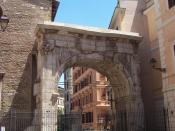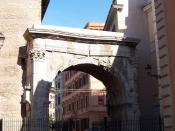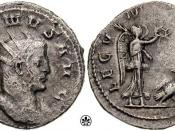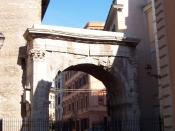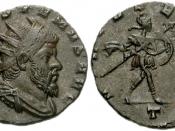Honors World History10/24/08Content PagePage 1 . . . . . . . . . . . . . . . Content PagePage 2 . . . . . . . . . . . . . . . IntroductionPage 2 . . . . . . . . . . . . . . . Birth/Death Date, Family,Early Life, Rise to powerPage 3-5 . . . . . . . . . . ÃÂ ÃÂ Summary of his reign:major events, major accomplishments, ` major problemsPage 4-5 . . . . . . . . . . . . . End of his reign and how it endedPage 5-6 . . . . . . . . . . . . . Evaluation of his reignPublius Licinius Valerianus Egnatius Gallienus, or Gallienus, was born in the year 218 A.D. His father, Publius Licinius Valerianus, or Valerian was a famous and great general in RomeÃÂs army beginning approximately 253 A.D.
All history presented by Gallienus concerning Valerian is presented in an extremely fragmentary manner, which denotes a very negatively biased view by Gallienus toward his father. Little is known about Valerian except that he served as part of the Senate, was a great general, and served as the emperor of Rome for a period. History also tells that Valerian married Mariniana and that a son, Gallienus, was born to them. Gallienus was very fond of Greek culture and also was wise in attempting to preserve as much of Roman history as possible. Otherwise, Rome would not have been worth the fight. During his reign, Gallienus traveled to Attica in Greece and was initiated into the mystery cult of Eleusis.
History at this time is marked by the inability of any Roman Emperor to maintain a strong grasp on the Roman Imperium. Gallienus was an exception to this rule due to his great successes as Augustus, the junior emperor next to his father Valerian. Gallienus was accepted as Augustus at an early age. Augustus in Latin means ÃÂthe increaser,ÃÂ ÃÂvenerable,ÃÂ or ÃÂmajestic.ÃÂ Valerian decided that it was important for him to share power equally with his son and placed Gallienus in charge of the entire western portion of the Roman Empire. This allowed for an extremely flexible rule over Rome. GallienusÃÂ reign was one of constant defense from invasion of foreign peoples. Gallienus rarely had any time to himself as he was constantly defending remote regions of his empire or suppressing frequent rebellions all over his imperium. In the early years of his joint reign with his father, Gallienus focused on suppressing small invasions and the breakout of riots in conquered areas. Whenever a new person came into power over the Roman Empire, mass breakouts and rioting among the conquered people followed. These uprising had to be suppressed before anything else could be done. Gallienus dealt with defending the extremities of his portion of the empire from invasion of barbaric tribes and power hungry nations in the very beginning of his reign. Gallienus had put down many of these rebellions by the year 260 A.D. and ensured security by making an alliance with the Marcomannic king whose daughter, Pipa, he took as a concubine even though he was married to Cornelia Salonia.
In 257 A.D., Valerian rescued Antioch from Persian control, but only temporarily. In 259 A.D., after renewed Persian attacks, Valerian attempted to make peace with the Persian King Saphor. Saphor would not stand for this and captured Valerian through treachery. Valerian was then greatly humiliated by Saphor, who used him as a human mounting block for the kingÃÂs horse. Valerian was later skinned to make a more lasting trophy of King SaphorÃÂs cunning. This ended the life of Valerian. Through all of this, Gallienus does not seem to care that his father has died and seems not to notice that his father never returned from Persia. Gallienus simply stepped in to the role of full emperor of the Roman Empire without a second thought. Also around this time, Gallienus began to separate the civil and military functions of RomeÃÂs provincial governors by making them into lowly civil administrators.
GallienusÃÂ chief way of reinforcing his position as emperor is seen through the coins during this time. The coins from this period show evidence of a successful propaganda campaign in a time thousands of years before television or newspapers. Many of the Roman mints in this time produced coins depicting soldiers and the message ÃÂFIDES MILITVMÃÂ or ÃÂloyalty of soldiersÃÂ despite constant rebellion of armies against Gallienus. Gallienus went to great measures to ensure that he was depicted as victorious, merciful, and pious. In addition, Gallienus introduced a new coin series to the general public depicting his portrait disguised as several of the Greek deities. Roman people who used these coins every day were constantly reminded of their Greek heritage and therefore remained loyal to the Emperor.
During GallienusÃÂ reign, there was constant fighting on the western frontier of the Roman Empire. By the year 260 A.D., Gallienus had lost complete control of Gaul. In the traditional fashion, Claudius II Gothicus gained the loyalty of the army and succeeded Gallienus to the Imperium. In the months leading up to his mysterious death in September of 268 A.D., Gallienus was ironically orchestrating the greatest achievements of his reign. An invasion of Goths into the province of Pannonia was leading to disaster and even threatening Rome, while at the same time, the Alamanni were a creating a ruckus in the northern part of Italy. Gallienus halted the progress of the Alamanni by defeating them in battle in 268 A.D., and then he turned north and won several victories over the Huns. That fall, he attacked the Goths once again. In September, either he or Claudius, his leading general, led the Roman army to victory at the Battle of Naissus.
At some time following this battle, Gallienus' authority was challenged by Aureolus, commander of the field army in Milan, who supported Postumus. Gallienus moved to lay siege to Mediolanum, but during the siege he was murdered. He died in 268 A.D. There are different accounts of his murder. According to the Historia Augusta, an unreliable source compiled long after the events it describes, a conspiracy was led by the commander of the guard Aurelianus Heraclianus and Marcianus. Cecropius, commander of the Dalmatians, spread the word that Aureolus was leaving the city and Gallienus left his tent without his bodyguard, only to be struck down by Cecropius (Historia Augusta - Gallieni, xiv.4-11). One version has Claudius selected as emperor by the conspirators, another chosen by Gallienus on his death bed. The Historia Augusta was concerned to substantiate the descent of the Constantinian dynasty from Claudius, and this may explain its accounts, which do not involve Claudius in the murder. The other sources, (Zosimus and Zonaras), report that the conspiracy was organized by Heracles, Claudius, and Aurelian. As a final act of spite against Gallienus, the Roman Senate defied Gallienus a proper burial in one of the elaborate Roman mausoleums. The Senate ordered GallienusÃÂ body to be laid to rest in a tomb nine miles south of Rome along the Via Appia.
Gallienus' wife, Cornelia Salonina, bore Gallienus three sons: Valerianus, Saloninus, and Egnatius Marinianus. Valerianus died in 258 A.D. Salonius died after becoming co-emperor. He was killed by his tutor, Posthmus. Egnatius Marinianus became a consul in 268 A.D. Claudius spared the lives of Gallienus' family and declared his predecessor defied.
Gallienus, in large part, has been passed over by historians. Part of this is due to GaulÃÂs secession and the fact that Gallienus was unable to reconquer it. Recently, Gallienus has begun to be seen in a more positive light. He was the creator of some very useful reforms. His most prominent contribution to military history was the creation of a cavalry only unit of the army, which could be dispatched quickly without all of the usual red tape involved in activating the army. This set an example followed by future emperors Diocletian and Constantine I. Gallienus also forbade Senators from becoming military commanders. This greatly undermined the SenateÃÂs power as equestrian commanders rose to prominence. These reforms not only helped Aurelian to salvage the empire, but also placed Gallienus in the league of the Roman Dominate along with Septimius Severus, Dicletian, and Constantine I. Gallienus was one of the last rulers to be called ÃÂFirst Citizen.ÃÂ His self promotion laid the foundation for the emperors who would be addressed as ÃÂLord and God.ÃÂWorks Cited1.Author Unknown. "Publius Licinius Egnatius Gallienus." Roman-empire.net. Date published unknown. 25 Oct. 2008 .
2.Gallieni. Historia Augusta. Chapter xiv. Page 4-11.
3.Wiegel, Richard D. "Gallienus." Roman-emperors.org. 3 Aug. 1998. Western Kentucky University. 25 Oct. 2008 .
